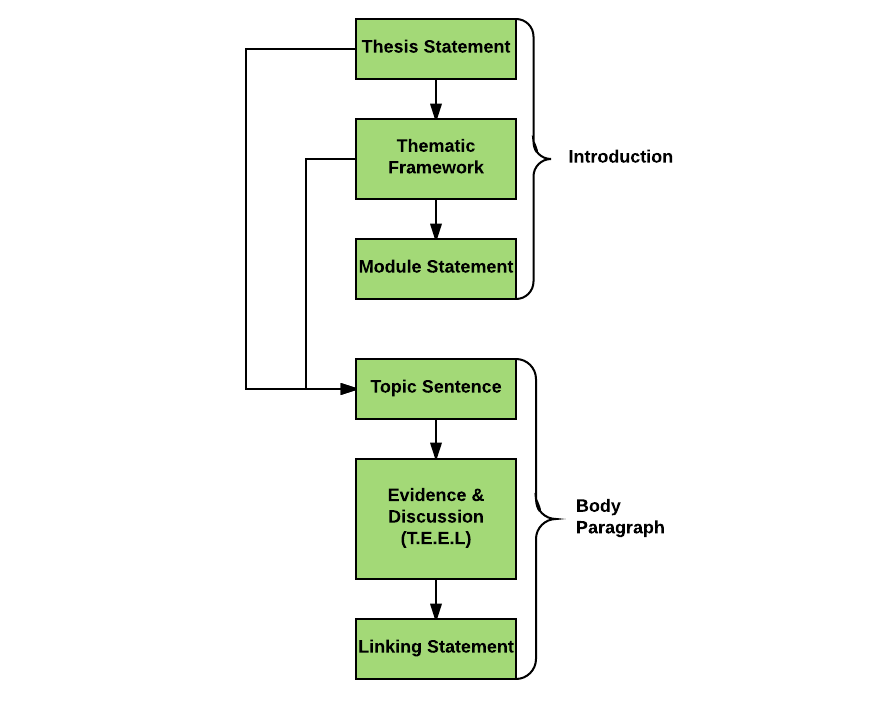Welcome to Matrix Education
To ensure we are showing you the most relevant content, please select your location below.
Select a year to see courses
Learn online or on-campus during the term or school holidays
Learn online or on-campus during the term or school holidays
Learn online or on-campus during the term or school holidays
Learn online or on-campus during the term or school holidays
Learn online or on-campus during the term or school holidays
Learn online or on-campus during the term or school holidays
Learn online or on-campus during the term or school holidays
Get HSC Trial exam ready in just a week
Get HSC exam ready in just a week
Select a year to see available courses
Science guides to help you get ahead
Science guides to help you get ahead

Welcome to part 3 in our Essay Writing Series, How to Write a Topic Sentence.
Some common questions that students have are:
In this post we will show you how to write a topic sentence. And explain how it fits into the broader essay structure.
Students often struggle as they try to produce sustained arguments, and then don’t know where they go wrong. They think it is their content they need to fix, when it is actually their structure. This is because students don’t understand how structure produces a clear and sustained thesis throughout an essay. Clear and consistent topic sentences are essential to this process.
A topic sentence is a statement that introduces the idea that will be discussed in a body paragraph. Topic sentences tell a reader what you will be arguing in a body paragraph. It is important that they are concise and direct, and also carry a direct connection to the introduction. This will help orientate the reader.
Structure plays a crucial role in conveying your ideas and arguments to your marker. You don’t want your reader to need to do any work when reading your essay. The argument must be laid out for them. This is what topic sentences do. They introduce the idea you will discuss in that paragraph.
Before we compose a topic sentence, let’s recap our understanding of essay structure and signposting.
Knowing how to write topic sentences and connecting them to your thesis is essential to good essay structure. In this post, we will discuss how to write a topic sentence that connects to your thesis statement. Remember, it’s one thing to have a solid thesis statement, but you need to know how to write a topic sentence that connects to your thesis to develop a sustained argument.
You will have heard your teachers talk about signposting. But what is it?
As readers, we like to be told what the argument is, and how it will be structured, before we hear it. Topic sentences are an integral part of this. They signal to your reader where they are in your essay. This helps your reader understand what you are about to argue, and, thus, aids them in following your argument.
Signposting is where you give clear signals to your readers about what you are discussing and how you will discuss it.
Topic sentences form a link between your thesis statement and thematic framework to your body paragraphs. Without topic sentences, your essay will lack structure and logic. Signposting is achieved by connecting your thesis statement to your topic sentences. These connections will help you craft a sustained argument!
Let’s have a quick look at the structure of an essay to see how these parts fit together to make a sustained argument.

You will see that the thesis and thematic framework clearly connect to each other in the topic sentences. Clearly, knowing how to write a topic sentence is essential if you want to get good marks for English.
Remember, your thesis statement is your answer to a question. It tells the reader the central idea you will argue in your essay or speech.
Let’s discuss how and why this works.
Develop essay writing confidence before the HSC exams with our Year 12 English Course! Learn more.
Start HSC English confidently
Expert teachers, detailed feedback, one-to-one help! Learn from home with Matrix+ Online English courses.
Your topic sentences are the statements you make at the start of a body paragraph to introduce the idea you will discuss in that paragraph. Topic sentences form a connection between the themes in your essay and your thesis.
This is a signpost to your reader reminding them of what you were going to discuss in the paragraph they are starting.
As we saw in the previous post, the thematic framework is where you introduce your themes and explain how you will discuss them. The statements you make about themes in the thematic framework will connect with your thesis statement to form your topic sentences.
The aim of a good essay is to produce a sustained argument. The connection between thesis and topic sentences is crucial to developing structural integrity in your essay. A thesis that has clear connections to the topic sentences that follow is essential for this. It will continually assert your argument throughout the essay! Thus, topic sentences are essential for orientating your reader in the logic of your essay.
Once somebody has read your thematic framework, the topic sentences will act as signposts signalling where you will discuss a key idea. This will help your markers understand how the various ideas you rely on support your argument.
If you haven’t already, you should read our post How to Structure Your Essay Introduction| Essay Writing Part 2 before continuing. If you have, let’s look at a step-by-step process for writing topic sentences.
Once you have a thesis and thematic framework, you can write your topic sentences.
Remember, topic sentences must clearly connect our body paragraphs to the introduction, this will develop a sustained argument and reflect the focus of our thesis.
Now, let’s look at how to do this.
As we have said, topic sentences provide a signpost for your markers that explains what idea you will explore in a particular body paragraph and clarify how it connects to the thesis and module. Similarly, topic sentences also serve as a reminder of what your specific argument should be. This will help you stay focused on a singular idea and present a sustained argument.
So, let’s see what our topic sentence needs to address.
In the last post we looked at the question:
“William Shakespeare’s Macbeth is not about revenge, it is a play concerned with morality and madness.”
To what extent do you agree with this statement? Make use of detailed references to the play in your response.
To recap, our argument was that:
In the previous post, our thesis statement was:
“The resolution of The Tragedy of Macbeth (1606) is driven by revenge. However, it is Shakespeare’s interrogation of the morality of Macbeth’s actions and his subsequent descent into madness that is the central focus of the text.”
And, similarly, our thematic framework introduced the following thematic points:
A good topic sentence will take a key aspect of the thesis statement and combine it with the central idea from the thematic framework.
Remember, a topic sentence introduces the paragraph and signposts to the reader where they are in your argument. Our topic sentences need to reflect this. This means that we need to take the idea from the thematic framework and combine it with your thesis.
Let’s write one!
Now that we have a thesis, a thematic framework, and our structure, we can discuss writing topic sentences.
First we must take our thesis statement and look at its key ideas:
“The resolution of The Tragedy of Macbeth (1606) is driven by revenge. However, it is Shakespeare’s interrogation of the morality of Macbeth’s actions and his subsequent descent into madness that is the central focus of the text.”
We’ve bolded the key ideas pertaining to “revenge”, “morality”, and “action and madness”.
We now need to combine these ideas with the statements from the thematic framework. Let’s look at how to do this effectively for each theme:
If we combine this theme with our thesis’ focus on “revenge” we get:
This sentence indicates that our first paragraph will explain the role of revenge in the text. It also explains the importance of revenge to our argument. This reflects our thematic framework and thesis statement.
If we combine this theme with our thesis’ focus on “interrogating morality” we get:
This topic sentence adheres to the order of our thematic framework while asserting the role of morality in our argument.
If we combine this theme with our thesis’ focus on “madness” we get:
This topic sentence introduces the theme of madness and allows us to connect the three themes together. The reference to paranoia allows us to discuss the role of revenge in Macbeth’s madness and his flawed morality. This will allow us to finish our argument and tie the various ideas together.
These topic sentences connect clearly to the introduction’s thesis and thematic framework. This is what makes a sustained argument. While it may seem a little repetitious, it is forging an interwoven and nuanced response to the question. This is what your markers want. This is the structure you need to emulate!
Once you have produced the foundations of your essay, the next step will be to support your argument with evidence. This means writing body paragraphs.
You can read how to do this in our next post: How to Write a Body Paragraph | Essay Writing Part 4.
To develop these skills further, you need to write practice essays.
© Matrix Education and www.matrix.edu.au, 2025. Unauthorised use and/or duplication of this material without express and written permission from this site’s author and/or owner is strictly prohibited. Excerpts and links may be used, provided that full and clear credit is given to Matrix Education and www.matrix.edu.au with appropriate and specific direction to the original content.